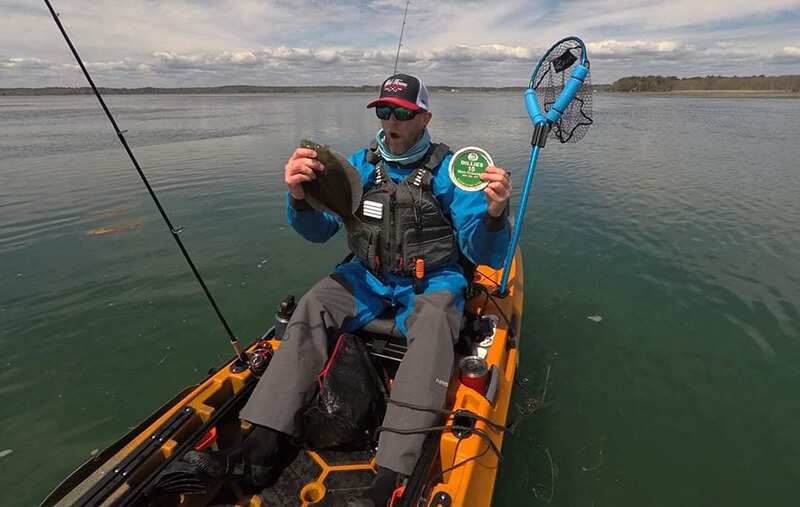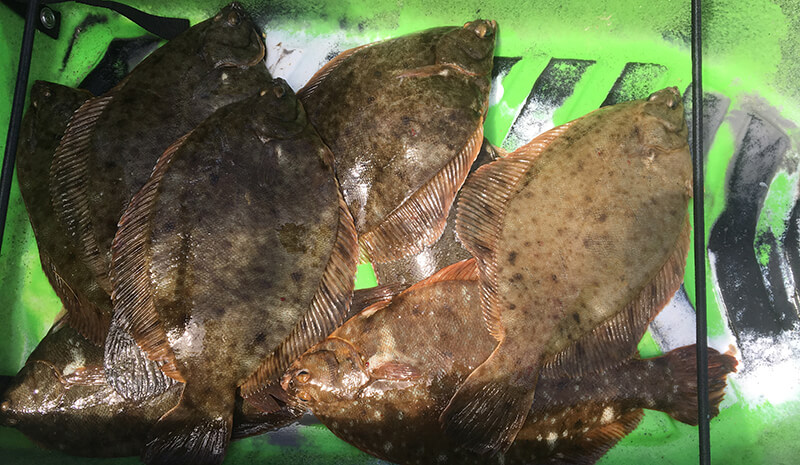Kayak Flounder Fishing With Tim Moore Outdoors
During the months of May and June, winter flounder move into harbors, shallow bays, and tidal creeks along the New England coast. They seem to be most prevalent from Boston Harbor to the New Hampshire/Maine border. They get their name (Winter Flounder) due to the facet that they spawn in winter. After they spawn and the waters begin to warm, they’re hungry. They move into slow-moving shallow water and feed aggressively, making them easy (for those who know where to look and how to fish for them) easy to catch them.
From what I have been told, a flounder was the first fish I ever caught. Back then they were plentiful and easy to catch. You could catch them on almost any mud or sand bottom in the seacoast New Hampshire and southern Maine coastal areas. As a kid, catching flounder in saltwater was the equivalent to catching bluegills in freshwater. They were easy. So easy that me and my cousins were often given a container of sea worms, clam necks, or even earth worms so we could sit on the family float and catch them until we were sick of it. I was almost always the last one to quit.
There were loose or no limits back then, and between recreational anglers filling buckets with them, and commercial fishermen taking as much as they could catch, flounder numbers had dwindled to the point that they weren’t even worth fishing for. However, due to stricter catch and bag limits, flounder populations along the New Hampshire coast have rebounded over the last decade. I was elated to once again find them in catchable numbers and when I began kayak fishing, targeting flounder from my kayak seemed only natural.

In the spring, flounder typically arrive in the harbors, estuaries, and even tidal creeks around May first. They can be found in very shallow water. I’ve watched from the seat of my Sportsman BigWater PDL 132 Marsh Camo kayak as flounder have eaten my rig in water as shallow as four feet. I prefer to drift for them rather than anchor and chum, as flounder highly rely on sight as much as scent to feed. Chumming works very well, but it’s more work and it takes a while for the chum to attract fish. A moving flounder rig at the right speed and tide is an almost irresistible treat.
Flounder prefer sand and mud bottom, but they also like structure. They will often sit behind boat moorings, rock piles, and even on slopes, waiting for small bits of food or sandworms to drift or swim by. Harbors are especially attractive to flounder anglers because of the number of places (mooring blocks) for flounder to hide. I find that kayaks are much better suited (and far more effective) to drifting around mooring fields. Any kayak will do, but a kayak like one from the Old Town Sportsman line is going to be much more comfortable and easier to fish from. The smaller profile (as opposed to a big boat) also reduces spooking fish in the shallow water.

Flounder fishing from a kayak is a pretty simple process. A heavy trout-type or light saltwater spinning (or baitcast) setup is all you need. Two-hook flounder rigs can be purchased at most tackle shops and can be tipped with sea worms or clam strips, but earth worms will work in a pinch. Use as little weight as you can while still being able to keep your bait on the bottom. The use of a net will make handling your catch easier and help keep the second of the two hooks out of your hand while unhooking fish. Some anglers bring a small cooler to keep their fish in, but I would rather hang my catch in the cool spring waters on a stringer or in a catch bag until the water gets into the upper fifty-degree range.
I prefer overcast days with light wind, and try to time my trip so that the wind and the tide are in the same direction. This makes my bait more natural to the flounder when it drifts by. On days when the wind opposes the current and is strong enough to push me against it, the PDL is worth it’s weight in gold. I can slowly pedal to keep myself moving with the current. When the wind and current are the same, but the wind is blowing me too fast, I can pedal backwards to slow my drift. Keep your drift slow and your sinker on the bottom, and when you feel the subtle tapping of a flounder, reach out and give them a second to “climb on” before lifting your rod to lightly set the hook. As far as what time of tide is best, that is subjective to the time of day as well as time of year. Early mornings and late afternoons are usually best, but in May and early-June they can often be caught all day long.
Because kayaks are easier to get to the water and usually free to launch, they often put you in close contact to your quarry. With the Old Town Sportsman lineup, there’s a kayak for just about every type of angler, for pretty much any species that swims. Regardless of what gear you use, or which kayak model you’re in, never neglect safety. Dress for the water temperature, as they are generally cool, and always wear your PFD. It’s recommended to go with a friend, but if you go alone, file a float plan. Tell someone where you are going and when you think you’ll return.
Tim Moore is a full-time professional fishing guide in New Hampshire. He owns and operates Tim Moore Outdoors Guide Service. He is a member of the New England Outdoors Writers Association and the producer of Tim Moore Outdoors TV. Visit www.TimMooreOutdoors.com for more information.






